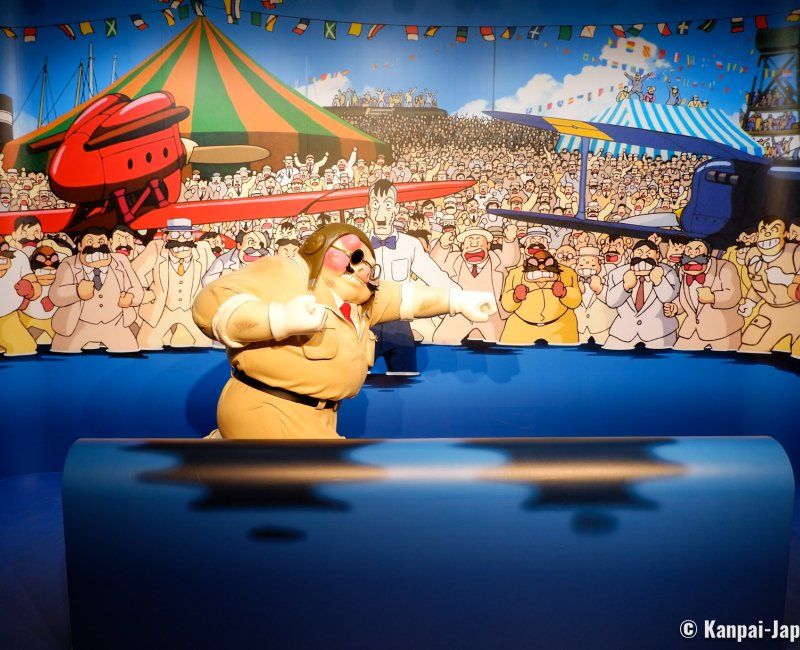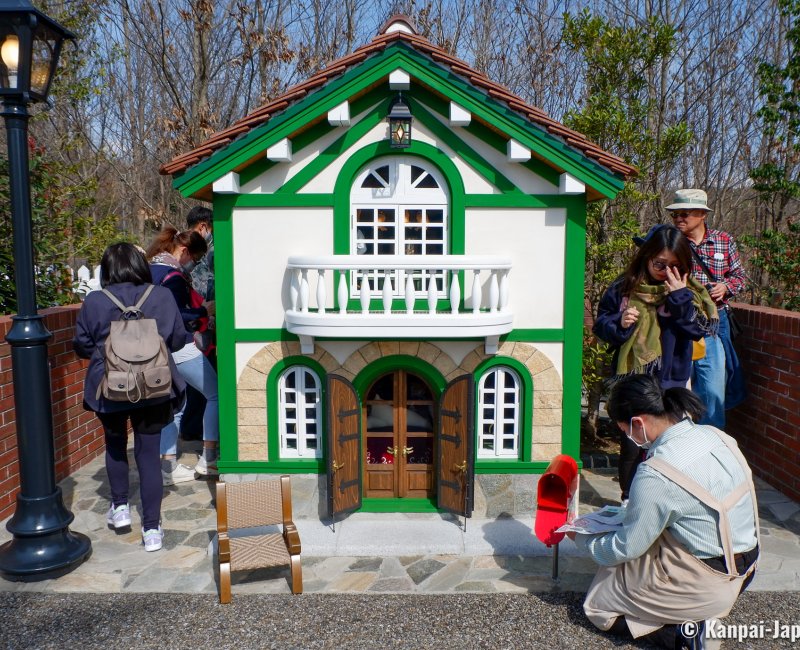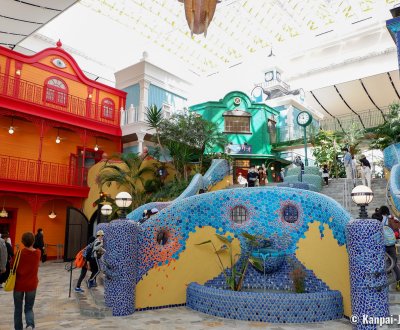Ghibli Park
Totoro’s Official Park in Nagoya
Ghibli Park is the 1st Studio Ghibli official theme park and is located in the Expo 2005 Aichi Commemorative Park (Moricoro Park) in Nagakute, a city east of Nagoya in Japan. Several worlds recreated with decors and settings based on the Studio’s animated movies, are now open for discovery, mainly targeting Ghibli’s long-time fans.
Studio Ghibli’s official park, announced on 2017, May 31 and named in English "Ghibli Park" opened to the public on 2022, November 1rst. The construction works started on 2020, July 28 and were completed without delay. The construction costs are estimated to ¥34 billion (~218.2 million dollars), including ¥3 billion (~19.3 million dollars) for design and layout.
Moricoro Park in Nagoya’s suburb is the perfect choice for the site as it was already home to Satsuki and Mei’s House, from My Neighbor Totoro, that was build for the Aichi World Expo in 2005 and opened to the visit ever since.
The project of Ghibli Park was therefore designed around this 1rst original reconstitution, and in close ties with Aichi prefecture, that operates Moricoro Park. Ghibli Park is a theme park 🎡 with recreations of settings from the studio's movies, and especially its famous film-maker Hayao Miyazaki’s movies. Do not expect the excitement of an attraction park, as there are no roller-coasters or thrilling rides there.
The press video below was shot on the day of opening:
Contrary to Tokyo’s Ghibli Museum, visitors can take pictures throughout most of the park’s grounds, indoor and outdoor, with specific stagings, given that the place was designed to be highly Instagrammable. Note that the staff is in full force and ensures that visitors respect the settings and instructions. It is not unusual to find waiting lines at the most popular photo spots.
Families are the main target of this amusement park, as shown in the selection of Ghibli movies on which its areas are based, with a will to welcome children as best as possible. Several playgrounds are also intended to younger children only (under 12 years old). Prams are allowed, but specific installations do not accommodate them and they must be left outside.
Access for persons with reduced mobility are available in most of the indoor and outdoor installations. Some are hidden in the decor and the staff, speaking a good English, can help you finding them.

5 worlds for children and Ghibli die-hard fans
Ghibli Park encompasses 5 areas on a 7,1 hectares superficies (of the 200 of the former Universal Expo’s site). Upon its opening, 3 worlds were available. The last 2 worlds opened successively in November 2023 and March 2024.
The Park is now offering a full experience into its 5 worlds.
The Grand Warehouse: the only immersive world
Named in Japanese ジブリの大倉庫エリア Ghibli Dai Sôko Area, Ghibli Grand Warehouse is a large indoor space of a 4,200m² superficies that includes mainly:
- Various life size movie decors;
- A 170-seats movie theater;
- Playgrounds for children; and,
- An avenue lined with small workshops and boutiques.
Ghibli Grand Warehouse is arguably the best experience in the Park, where one really feels immersed into the Studio’s universe, minus the covering structure that used to protect an indoor pool until 2018. Of the previous facilities, a skating rink is still operating next to the Warehouse! The exterior structure has been kept as such, (especially the ceiling and industrial looking windows) to the detriment of an overall "Miyazaki-ish" ambiance visitors might have expected.
Not overbearing, the decors selected from several Ghibli animated movies are well-made and display an incredible level of details, such as in:
- Yubaba’s office (Director's Room), that appears quite lively but is actually only a small space to watch from its window and door-frame;
- The world at Arrietty’s scale (The House Below and The Little People's Garden), which is nice to walk around, with a well-thought staging underground;
- The robot soldier from the Castle 🏯 in the Sky (Garden in the Sky) makes a lovely picture spot;
- Hanging from the ceiling, a flying ship partially hides the glass roof and brings some movement to decors otherwise mostly motionless.

The space in the Warehouse is divided into several zones mainly including exhibition galleries, 2 children’s playrooms (Cat 🐈 Bus Room and Children's Town) and a lovely old-fashioned shopping arcade (Minami-machi). The "Warehouse’s attic", a dim-lighted area, is filled with decoration items that were used during previous Ghibli events in Japan and in the world.
We highly recommend visiting the 3 special exhibitions opened in the year of the park’s inauguration:
- Delicious! Animating Memorable Meals Expanded Edition, a mouth-watering food wax replicas exhibition displaying the most iconic meals drawn by the Studio, as well as storyboards and authentic drawings of food scenes;
- Everything Ghibli! gathers all the posters created for movies and DVD releases;
- Becoming Characters in Memorable Ghibli Scenes is the most interesting and popular installation in the Warehouse. In a life-size quiz for long-time fans, a course recreates iconic scenes from 13 of the Studio’s movies. It is a fun area where one can become a Ghibli character for a moment and snap a picture. To shorten the waiting time, prefer the queue for free pictures, without people pausing.

However, we were slightly disappointed by:
- Cinema Orion, as the theater is airing the same short films as Tokyo’s museum. It feels like a missed opportunity to create something new for the occasion;
- The souvenir shop, while the largest of the park, its visit can create a frustration as the most popular or new products are frequently sold out by the end of morning and consequently unavailable when shopping later in the day; and,
- The restaurants in the park, that lack choices and imagination, whereas these are usually Japan’s forte; you can only order an ordinary Italian pizza or a sandwich in the Warehouse’s cafe.
The rest of Ghibli Park consists of outdoor universes with an average of 1 or 2 significant pavilions to explore in each area.
The Hill of Youth
Named 青春の丘エリア Seishun no Oka Area in Japanese, the Hill of Youth is inspired by the movie Whisper of the Heart and displays in particular a 19th century steampunk style elevator-tower, a reconstitution of the Chikyuya shop and of the study from The Cat Returns.
From the Linimo station’s exit, the Elevator Tower is the primary access to the Hill of Youth and its park below. Its clock and upper balcony areopen to everyone. From there, one can head to the 2 buildings characterizing this 1rst area:
- The antique shop and violin workshop World Emporium; and,
- The very well-made office with Baron and Muta in a lovely tiny house fitting the size of the cats.

The Dondoko Forest
The Dondoko Forest, called どんどこ森エリア Dondoko Mori Area in Japanese, is a large woody area surrounding the house from My Neighbor Totoro, built in 2005, with an about 5-meters tall wood statue of Totoro in a children’s playground.
This world is located further away in the Commemorative Park, behind Toromon Gate and encompasses:
- Dondoko-do, a kind of small temple dedicated to Totoro as a kami. Its statue is also a playground for children who can climb inside. Original omamori amulets are also available to purchase. It can also be reached riding the little old-fashioned tram; and,
- Satsuki and Mei’s House, that preceded the opening of the park and benefited from a refreshing of its colors. The pleasure is the same as before as one can touch the objects, open the drawers and check every nook and cranny of the house.
Totoro’s universe is well transcribed in the buildings, but the forest lacks density and is not overbearing, especially in winter when the trees have lost their leaves. Next to this area, there is a humble Japanese stroll garden and its pond, and a place to have a matcha tea. Dondoko Forest is more of a walk in a park than a truly immersive experience.

Mononoke’s Village
Inaugurated on November 1rst, 2023, もののけの里エリア Mononoke no Sato Area in Japanese, Mononoke’s Village includes a reconstitution of the Tatara Forge and the Emishi Village, as well as a space for taking a rest.
While it is drawn from Princess Mononoke, one of the most marvelous of Miyazaki’s movies, Mononoke’s Village happens to be quite disappointing with poor decors:
- The Emishi Village’s watch tower, from the animated movie’s first scene, with only 2 mosaic statues of the parasite-infested creatures (Lord Okkoto and Demon Spirit); and,
- Tatara-ba, the house of the forge, where, for an additional fee, one can take part to a cooking activity. It usually consists in charcoal grilling a gohei-mochi which is a skewed glutinous rice confectionery coated in a sauce. The house’s roof is covered with grass.
A couple of fields, especially a rice paddy, surround the buildings in this area.

The highlight of the park: the Valley of Witches
Called 魔女の谷エリア Majo no Tani Area in Japanese, the Valley of Witches is the most recently opened world of Ghibli Park (on June 16, 2024). it is largerly inspired by Howl's Moving Castle, Kiki's Delivery Service and Earwig and the Witch.
The Valley of Witches is the newest pleasant surprise in Ghibli Park: its mini-village with a "Miyazaki-like" atmosphere offers a lovely and enchanting walk (at last!). A lot of efforts was put into the creation of the decor making it the outdoor space with the most buildings to see and visit, such as:
- Howl’s Castle, the main attraction of the area, towering at 16 meters high. The structure’s inside is open to the visit and is decorated with a few moving elements;
- Sophie’s hat shop, Hatter's Millinery, also from Howl’s Moving Castle;
- The Okino Residence and its garden, which is Kiki’s house before she leaves to start her witch training;
- The Guchokipanya bakery, where Kiki settles down and lives; and,
- The House of Witches, where Aya is adopted and lives.
The area also has places to eat like Hot Tin Roof, a hot dog stand serving black or white cat paw-shaped bread, in reference to Jiji and their family. The Flying OVEN is a large restaurant in a European style red bricks building.
The village also has two rides (Carousel and Flying Machine) that can be used with an additional fee. Also worth mentioning are the Tower of Aviators a small indoor playground and the Clock Tower, that offers a nice elevated view.

The Expo 2005 Aichi Commemorative Park as a backdrop
The park’s map provided at the entrance shows that Ghibli worlds independent from one another: the Hill of Youth, the Grand Warehouse and the Valley of Witches are next to each other at the center of Moricoro park, with a fast access from the northern entrance served by public transports, whereas the Dondoko Forest, for example, is located in the opposite direction in the south.
Connection between the different areas is made by walking paths belonging to the Expo 2005 Aichi Commemorative Park, that are open to everyone and are not part of Ghibli Park. Ghibli Park is therefore better understood if considered as a group of themed universes located in an overall, third-party distinctive space. It may be probably why there is no airing of any Ghibli movies’ soundtracks, and visitors may somehow miss Joe Hisaishi’s melodies.
Since March 2024, a Toyota car 🚙, whose designed was inspired by the famous Catbus from My Neighbor Totoro transport visitors to the farthest areas: Mononoke’s Village and Dondoko Forest. The vehicle can board up to 5 passengers and one driver, and offers comfortable seating as soft as a cat’s fur. To ride the first Nekobasu in the world, one must buy a ticket in the park at the APM Cat Bus vending machine, which was illustrated by Hayao Miyazaki.
So instead of being completely immersed into Ghibli’s world, as it could be expected from a classical theme park, visitors are offered to enjoy and navigate the various installations of Moricoro Park: the most recent built for the Studio and the older ones remaining from the 2005 World Expo, such as:
- The central structure of the park, home to the Ghibli Grand Warehouse and a non-related skating-rink;
- A Ferris wheel, the highest in the Tokai area;
- The park’s layout, characteristic of its history with various ponds, large lawns, several concrete buildings and large rectilinear paths from the station’s exit.

Online tickets with limitations
Last but not least, getting a ticket for Ghibli Park is quite a feat already. Despite affordable prices compared to other large Japanese attraction parks such as Tokyo Disney Resort and Universal Studios Osaka, tickets are only purchasable online through an unnecessarily complicated process:
- Tickets must be booked 2 months in advance, and there is no ticket sale at the door. The official tickets go on sale on the 10th each month for the full month set 2 months ahead (M + 2) on a "first come, first served" basis. For example, July tickets are available to purchase starting May 10 at 2 p.m. (Japan Standard Time).
- Since March 2024, it is possible to buy multi-areas passes, with various restrictions of use, such as a "Premium Pass" that includes the whole park and is consequently the most popular.
- Visitors’ place of residence is taken into account when purchasing and they must select accordingly a domestic ticket or an international ticket, as caps are set on visitors’ numbers and ticket types.
- Lastly, one must select a specific day to enter the park and a time slot, especially to enter the Warehouse.
In August 2025 for the 20th anniversary of Aichi 2005 Expo, Ghibli Park opens until 8 p.m. on the 3 first week-ends of the month. Online booking is required starting June 10th.
Note that unfortunate die-hard fans who could not get their ticket can still go to the Lawson konbini at the northern entrance of the park, in the Rotunda Kazegaoka shopping area, to purchase Ghibli Park’s official goods. The Expo 2005 Aichi Commemorative Park however is open to everyone whether or not one has a ticket for Ghibli Park.

Purchasing a Ghibli Park Pass from overseas
Foreign visitors not living in Japan can get Ghibli Park Passes when booking for a full trip with specialized travel agents such as Keikaku, or try their luck with international online booking platform like Klook and Lawson.
We recommend the following course for exploring the Park (depending on the timed-entry ticket):
- Start your day in the morning by the Grand Warehouse, since it is the least crowded moment and the area really worth a lengthy exploration (it can also be the place you choose to visit last); then,
- Continue to the Valley of Witches, the 2nd most interesting area;
- In the early afternoon head to Dondoko Forest, and,
- End by Mononoke's Village and the Hill of Youth (optional worlds).
Note that no re-entry is allowed once you have exited an area.
Ghibli Park was expecting 1 million visitors on the 1rst year, then 1,8 million per year after the 5 areas are opened. At this point, a ¥48 billion (~308.1 million dollars) of yearly revenue is expected.
While beautiful and enlivened with a lot of details, Ghibli Park is not immersive enough, and located in an area that is not convenient to travelers in Japan. It is therefore mainly aimed at people passionate about the Studio’s animated movies and families with young children. Summer visitors should know that the walking paths connecting the worlds are under direct sunlight and that it can be very hot: they are advised to bring sunshade or to ride one of the free or paid (Catbus) shuttles.



